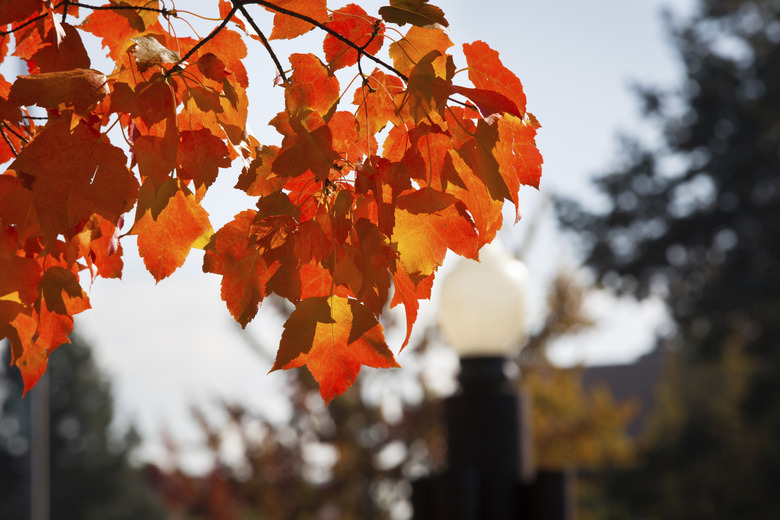'Autumn Blaze' Maple Problems
Autumn Blaze (Acer x freemanii "Jeffersred"), a hybrid of red maple (Acer rubrum) and silver maple (Acer saccharinum), inherited its fall color from the red maple and its rapid growth from the silver maple. It also inherited a susceptibility to diseases and insect problems that afflict both parents and root problems of silver maple.
Autumn Blaze Diseases
Controlling diseases and insects with fungicides and insecticides is usually not practical on a large tree, but you can apply chemicals with a backpack sprayer while the tree is small. The fungal disease anthracnose, most severe in wet weather, causes leaves to turn brown and kills twigs and branches. Spray three times, two weeks apart, with a fungicide containing the active ingredient mancozeb at the rate of 3/10 fluid ounces of mancozeb per 1 gallon of water, or according to label rates. Phyllosticta leaf spot causes spots that are yellow in the center with purple borders. This disease can cause the Autumn Blaze maple to drop its leaves all over or in certain parts. Spray with mancozeb three times, two weeks apart, when the leaves begin to unfold in the spring. Tar spot forms yellow spots on the leaves in early summer. In late summer, raised, tarry spots form on the yellow spots, causing leaves to drop prematurely. They are showy but do little damage. As with phyllosticta leaf spot, spray with mancozeb three times, two weeks apart, on new leaves in the spring. There is no treatment available for home use for bacterial leaf scorch, which causes leaves to fade or turn brown and kills limbs. Diseased trees lose vigor and can eventually die. A certified arborist may be able to save the tree.
- Autumn Blaze (Acer x freemanii "Jeffersred"), a hybrid of red maple (Acer rubrum) and silver maple (Acer saccharinum), inherited its fall color from the red maple and its rapid growth from the silver maple.
- There is no treatment available for home use for bacterial leaf scorch, which causes leaves to fade or turn brown and kills limbs.
Autumn Blaze Insect Pests
Tiny aphids feed on the bottoms of leaves and on shoots and buds, secreting a sugary material that develops dark fungal growth. Spray aphids on smaller Autumn Blaze maples with an insecticide containing the active ingredient permethrin when they appear and repeat in a week or 10 days. For a 1 gallon of 2 percent solution suitable for a backpack sprayer, mix 6 2/3 ounces of permethrin to 121 1/3 ounces of water. Small, immobile scale insects suck sap from the stem and cause stunted leaves that turn yellow and drop early. Spray with permethrin when the scales first appear and repeat every 10 days.
Autumn Blaze Root Problems
The roots of Autumn Blaze, like its parent silver maple, lack the ability to adequately stabilize iron in the soil, leading to chlorosis or yellowing of the leaves caused by iron deficiency. To help roots access iron, work 4 inches of compost into the top 12 inches of soil well beyond the outermost branches. utumn Blaze roots can become entwined at the base of the tree or wrap around a large root. This problem, called girdling, can cause poor vigor, small leaves, leaf scorch and the death of small limbs. Remove the circling root and treat the cut with wound paint. To help the tree recover, measure the tree at 4 1/2 feet above the ground and apply 3 to 5 pounds of 10-6-4 fertilizer for each 1 inch of the trunk diameter.
- Tiny aphids feed on the bottoms of leaves and on shoots and buds, secreting a sugary material that develops dark fungal growth.
- The roots of Autumn Blaze, like its parent silver maple, lack the ability to adequately stabilize iron in the soil, leading to chlorosis or yellowing of the leaves caused by iron deficiency.
Autumn Blaze Legal Issues
You cannot legally propagate a patented plant from root cuttings. You can legally grow Autumn Blaze from seed, but the tree that results may not be like the original. You can legally root a cutting of the nearly identical Freeman maple (Acer x freemanii), a hybrid of the red maple and silver maple that was developed in 1933. You can grow both Autumn Blaze and Freeman maple in U.S. Department of Agriculture plant hardiness zones 3 through 8. Silver maple and red maple grow in USDA zones 3 through 9.
References
- Clemson Cooperative Extension: Maple Diseases and Insects
- Missouri Botanical Garden: Acer Freemanii x Autumn Blaze
- Washington State University Clark County Extension: Autumn Blaze Maple
- Oregon State University Extension Service: What Does it Mean When Nursery Plants Are Patented or Trademarked
- Arbor Day Foundation: Maple, Silver
- Arbor Day Foundation: Maple, Red
- North Carolina State University Cooperative Extension: Fertilizing Deciduous Shade Trees in the Landscape
